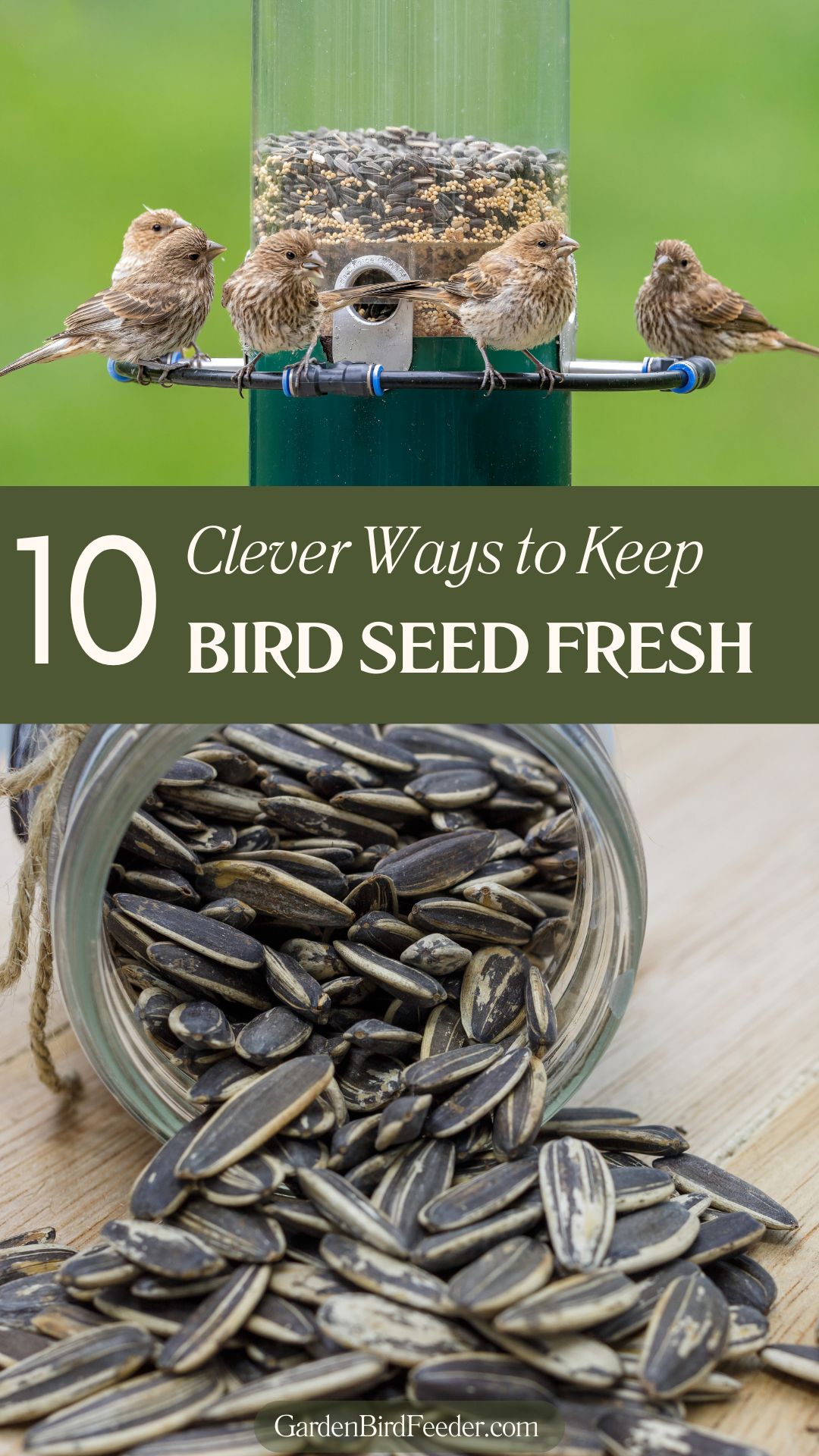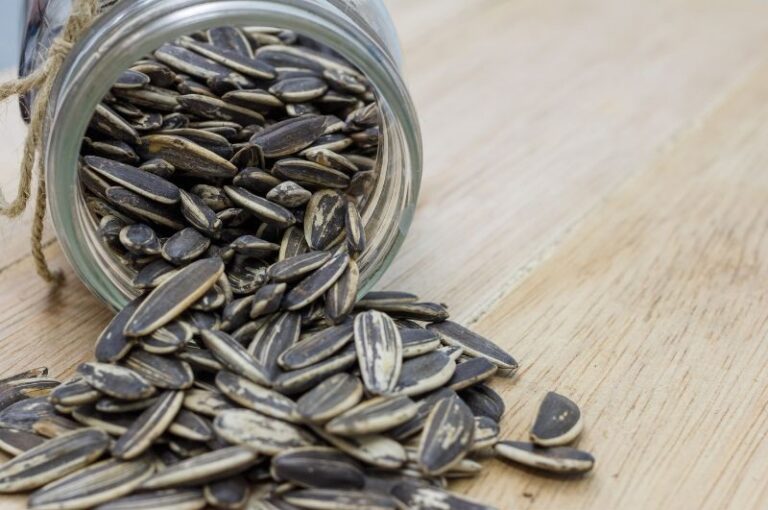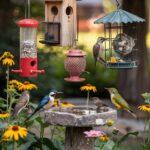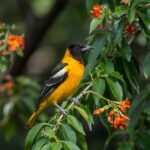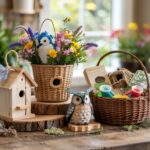Ever thought about how to keep your bird food fresh and organized? Feeding birds brings so much life and color to a garden or backyard.
Storing bird food the right way not only saves you money, but it also keeps birds safe from spoiled seeds and suet.
With spring migration on the horizon, plenty of birds will be searching for reliable food. If you set up a good storage system now, you’ll be ready to help both local and visiting birds.
From sunflower seeds to suet cakes, let’s look at some easy ways to keep your bird cafe stocked and fresh for all those hungry guests.
1) Store bird seed in airtight containers to keep moisture and pests out
Want your bird seed to last longer? Airtight containers are a game changer. They block moisture, so mold can’t grow and seeds stay fresh.
Critters like mice and bugs can’t get in if you seal things up tight. Honestly, a mouse will try anything to get at those seeds!
Glass jars, food-safe plastic buckets, and metal tins all work well. Just double check the lid fits snugly and closes up tight.
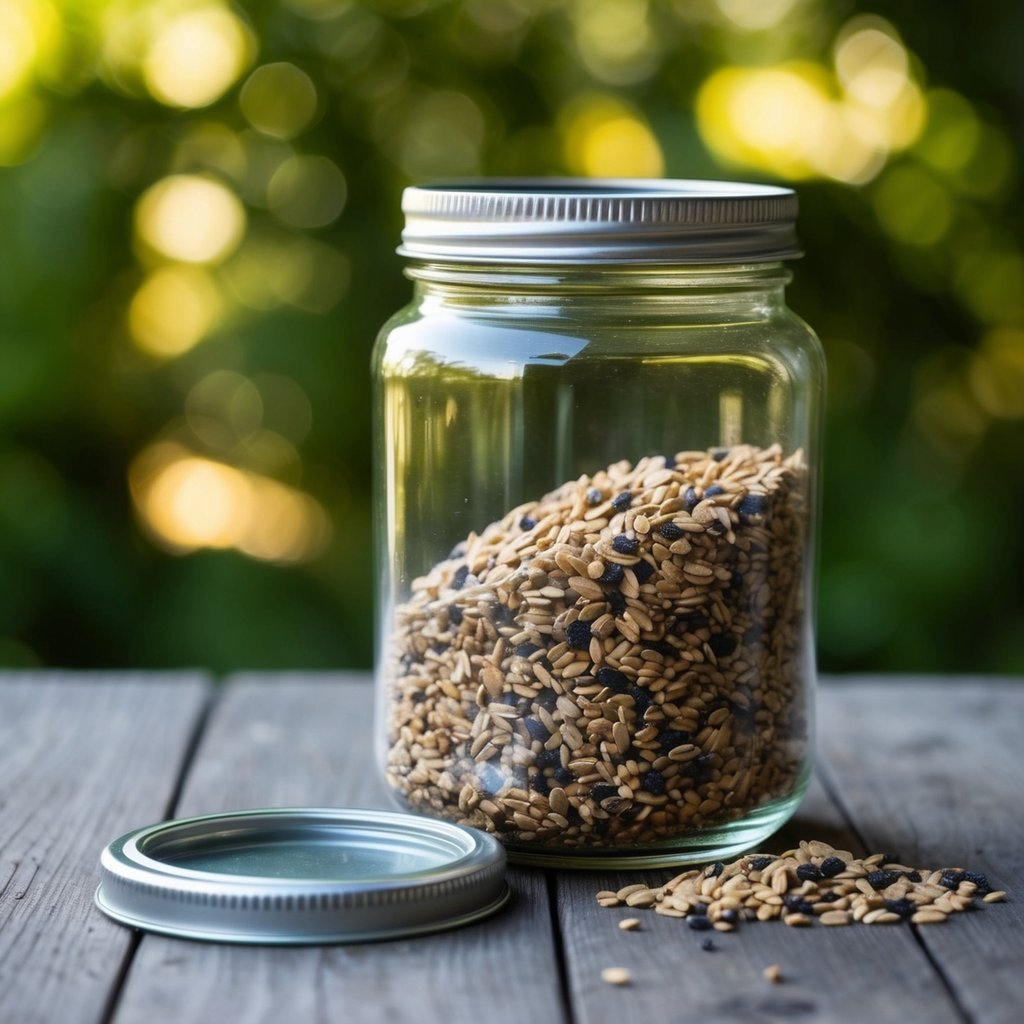
Bird seed isn’t cheap, right? Storing it properly in airtight containers really protects your investment.
If you live somewhere humid, toss a silica gel packet in the container. Those little packets soak up extra moisture and keep things dry.
Label your containers with the date you bought the seed. That way, you can use up the oldest stuff first and waste less.
2) Keep bird food in a cool, dry place away from direct sunlight
Where you store your birdseed is just as important as what you buy. Seriously, it makes a huge difference!
Always stash bird food in a cool, dry spot. Mold loves damp seeds and can be dangerous for birds.
Heat is no friend to bird food either. When seeds get too hot, they lose nutrition. Would you want to eat stale, bland food? Birds don’t either.
Sunlight can wreck seeds and suet quickly—it’s like leaving chocolate in the sun. Find a shaded spot in your garage, shed, or even inside your house.
Metal cans or sturdy plastic containers with tight lids work wonders. This one step can keep bird food fresh for weeks or months, depending on your climate.
Give your stored food a regular once-over for mold or bugs. A quick check can save you a lot of trouble and keep your birds safe.
3) Use metal tins for small amounts of seed to avoid quick spoilage
Ever notice your bird seed going bad faster than you’d expect? Moisture, heat, and pests are usually to blame. Metal tins are perfect for keeping smaller amounts fresh.
Metal keeps out critters that love to nibble on your bird’s snacks. Unlike plastic, metal won’t pick up weird smells or hold onto moisture.
Go for tins with tight lids—think old cookie tins. They seal up nicely and keep humidity out.
Seed in metal containers can stay fresh up to 30% longer than in flimsy plastic bags. Your backyard birds will definitely appreciate it.
Store these tins somewhere cool and dry. A pantry or garage shelf is great, as long as the temps don’t get wild.
Stick a label with the fill date on each tin. It’s a simple habit that helps you use up older seed first and avoid waste.
4) For larger quantities, plastic storage bins with tight lids work great
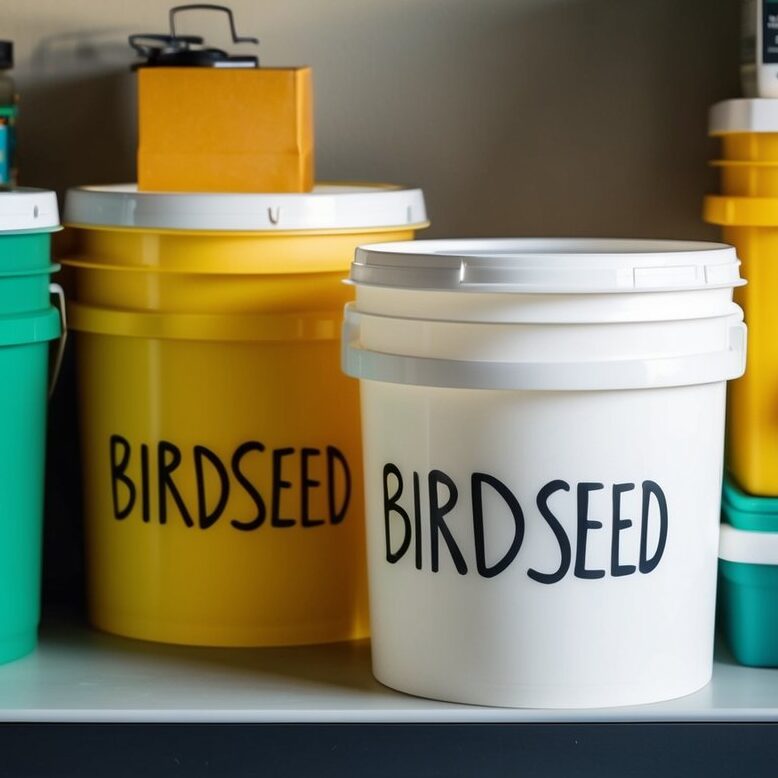
Got a big stash of bird seed? Plastic bins with tight lids are your go-to. They keep moisture and bugs far away from your birds’ food.
Pick bins that seal all the way around. It’s crucial to use waterproof containers so mold can’t sneak in.
Organize different seed types in separate bins. If you want to mix seeds, just use a broomstick and stir it up before you close the lid.
Clear bins are super handy—you can see when you’re running low without opening everything. Makes restocking a breeze.
Keep bins in a cool, dry place like a garage or shed. That way, your seeds last longer and stay fresh for your feathered guests.
5) Limit your seed supply to two to three weeks during summer to maintain freshness
Hot summer days can turn bird seed stale fast. It’s honestly surprising how quickly it happens!
Try buying smaller amounts during the summer. Why buy more than you can use in two or three weeks?
Seeds have natural oils that go rancid in the heat. Once they do, the seed loses nutrition and birds lose interest. No one wants to serve a stale meal.
Keep your stash in a cool, dry spot out of the sun. Garages or basements work well. Seed-producing plants give birds fresh food in nature, so your feeders should too.
Check your seed for mold or bugs every so often. Give it a sniff—if it smells musty, toss it out.
By sticking to a smaller summer supply, you keep the birds happy and coming back for more.
6) During cooler months, it’s okay to store up to six weeks’ worth of seed.
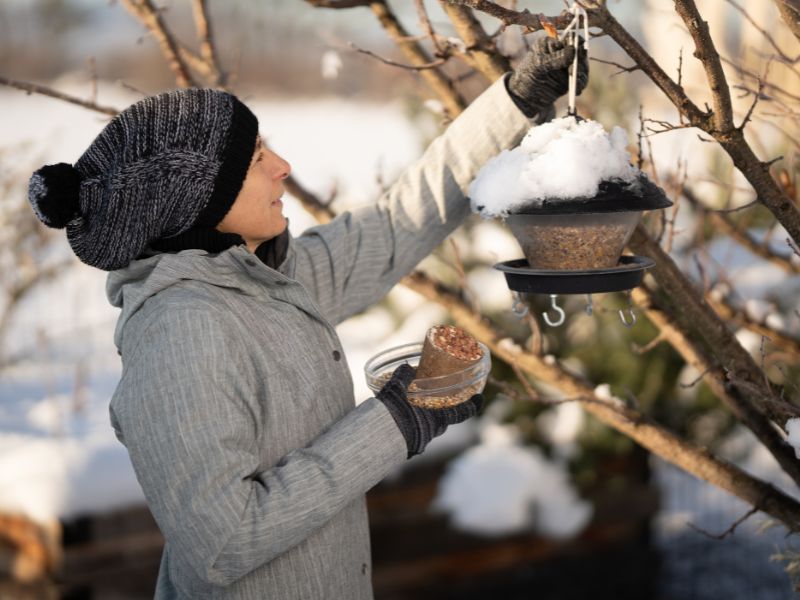
When temps drop, you can finally buy bird seed in bulk. Cold weather lets you save money and stock up a bit.
In winter, it’s safe to keep up to six weeks’ worth of seed if the weather stays cool.
Cooler temps slow down mold and bugs, so your seed stays fresh longer. Birds still get the nutrition they need, even after several weeks.
Just remember—dryness still matters. Even in winter, moisture ruins seed. Store it in a cool, dry garage or shed.
Sales pop up in the fall, so it’s a good time to buy extra. Now you know you can store it safely for a while.
Give your stash a sniff and a quick check every so often. If it smells off, it’s time for a new bag.
7) Inspect seed bags for dust or mold before storing or using them
Before you stash away bird seed, give those bags a quick look. Birds deserve the good stuff, and a minute of inspection can save you a headache.
Check for fine powder or dust—it’s a sign the seeds are breaking down or have been sitting around too long.
If the seed smells musty or moldy, trust your nose and toss it. Better safe than sorry!
Look out for tiny webs or bugs. They can ruin a whole bag and make birds sick.
Seeds should feel dry and firm. If they’re sticky or damp, bacteria and fungi aren’t far behind.
Always check new bags before bringing them home. Once you’re sure they’re fresh, move them into airtight containers. Your wallet and your birds will thank you.
8) Avoid overfilling feeders; Half-full ones reduce waste and spoilage
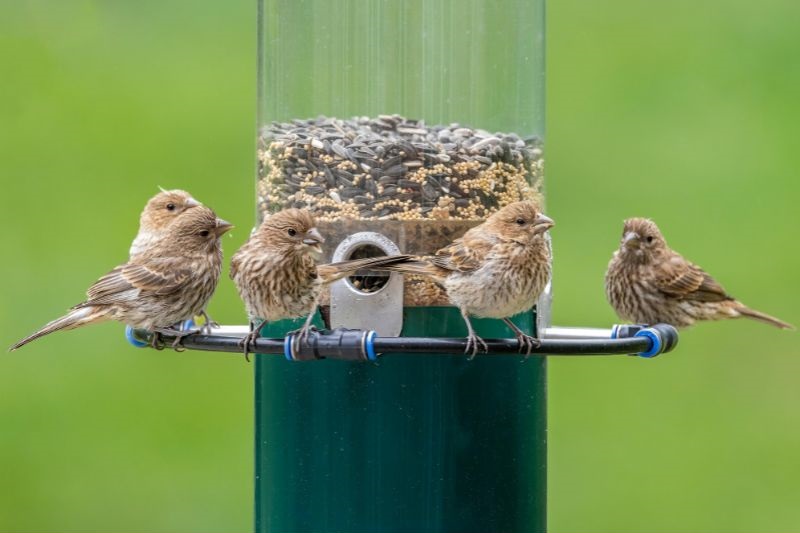
Do you fill your bird feeder to the brim? Honestly, it’s tempting, but not the best move. Filling feeders halfway makes food easier for birds to reach.
Half-full feeders keep food from getting wet and moldy at the bottom. This matters even more if you get a lot of rain.
You save money, too. Overfilled feeders often mean more seeds on the ground, which just attracts pests and wastes food.
Try marking the halfway point on your feeder with a sticker or marker. It’s a simple reminder to not overdo it.
In really humid places, filling just a third can work even better. Refilling more often means fresher food for your birds.
Give your feeders a quick check every few days. Fresh food keeps birds coming back and keeps them healthy.
9) Choose containers that are rodent and insect-proof for safe storage
Rodents can ruin up to 20% of the world’s food supply with their mess. Bird food isn’t immune!
Metal containers are a lifesaver for storing seed. They keep out mice and bugs that would love to snack on your stash.
Look for lids that snap or screw on tightly. Mice can squeeze through tiny gaps, so the tighter the better.
Glass jars are great for small batches of specialty seeds. You can see what’s inside, and they look nice too.
Heavy-duty plastic works for some, but keep an eye out for chew marks. Some rodents will chew through anything if they’re hungry enough.
Store your containers somewhere cool and dry, away from direct sun. That keeps seeds fresh and makes the spot less inviting for pests.
10) Keep seed storage off the ground to prevent dampness and contamination
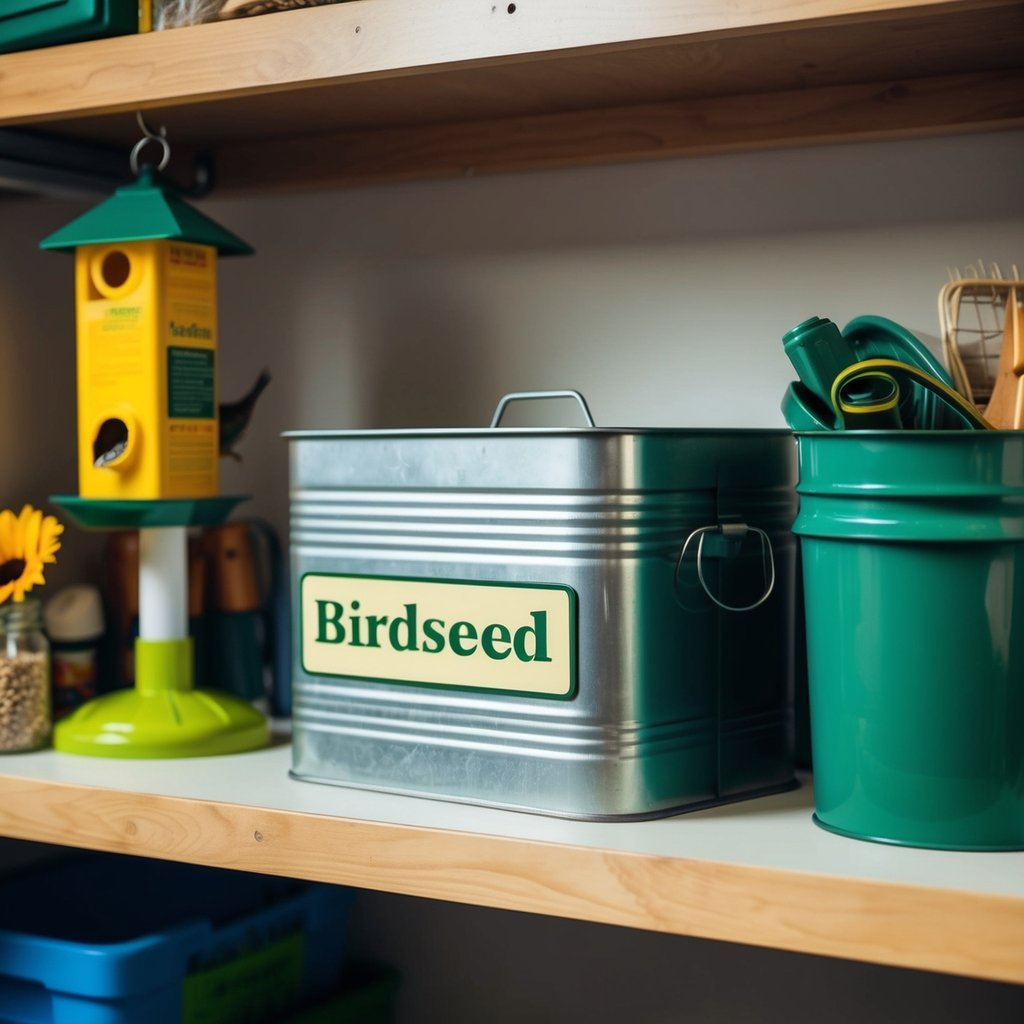
Storing bird seed right on the floor? That’s just asking for trouble. Lifting your seed off the ground is one of the easiest ways to keep it safe.
Seed bags on the floor can soak up moisture from concrete or tile, especially in basements. Dampness is a fast track to mold and mildew—no thanks!
Plastic shelving or metal racks work well. Keep your seed at least 6 inches off the ground for better air flow and easier pest spotting.
Mice and bugs reach ground-level bags much more easily. They’ll chew through plastic or paper without a second thought. Shelves put a barrier between pests and your seed.
Try sealed plastic containers on shelves for extra protection. The healthy soils birds love outside are full of microorganisms, but you don’t want those in your seed supply.
Check under your storage containers now and then for spilled seed. Even a small pile can invite unwanted critters.
Why Proper Bird Food Storage Matters
Proper storage isn’t just about being neat—it’s about your birds’ health. The way you store seeds, suet, and other foods can mean the difference between a healthy meal and a risky one.
How Freshness Impacts Nutrition
Bird food loses nutrition as it ages. Seeds and nuts have oils that go rancid, just like human snacks. Fresh seed has more fat and energy, which birds need, especially in cold months.
Old seeds lose nutrients and birds can tell. Sometimes they’ll just skip your feeder if the food isn’t up to par. Rotating your stock keeps things fresh.
Try crushing a seed between your fingers. If it smells weird or looks off, it’s time to toss it. Damp seeds can grow mold, which is dangerous for birds.
Risks of Improper Storage: Spoilage and Pests
Bad storage quickly turns good intentions into hazards. Wet seed breeds bacteria and mold, which can sicken birds.
Rodents and bugs love bird seed too. Once they find your stash, they contaminate it and chew through packaging. That wastes money and puts birds at risk.
To keep your bird food safe:
- Use airtight containers (metal is best for rodent-proofing)
- Store in a cool, dry spot away from sunlight
- Label with purchase dates so you use the oldest first
Fatty foods spoil quickly in summer, so be extra careful with suet when it’s hot. Your storage area should be cool, dark, and dry to keep food at its best.
Maintaining Quality in Different Climates
Storing bird food depends a lot on your local weather. Humid Florida? Freezing Minnesota? You’ll need to tweak your approach for best results.
Humidity and Mold: What You Need to Know
Is your seed getting clumpy? That’s humidity for you! Even inside, dampness can lead to mold that harms birds.
Quick humidity tips:
- Use airtight containers like glass jars or sturdy plastic bins
- Drop in a few silica gel packets to soak up moisture
- Keep seed in climate-controlled rooms if you can
- Buy smaller amounts during humid seasons
Have you sniffed your seed lately? If it smells musty, mold’s already there. Toss anything with visible mold—no exceptions.
For suet, keep it in the fridge if it’s humid. Birds don’t mind cold suet, but they won’t touch the moldy stuff.
Temperature Extremes: Prevention Strategies
Heat can turn the oils in birdseed rancid, and freeze-thaw cycles can make seeds sprout early. Either way, food loses its value for birds.
Temperature tips:
- Stash seed in a cool, dry basement during summer
- Keep containers out of direct sunlight
- In winter, let frozen seed warm up before filling feeders
- Consider a mini-fridge for suet storage all year
Nuts and mealworms need more care. Freeze-dried mealworms last at room temp, but fresh ones need the fridge.
Birds count on high-energy foods during wild weather. Good storage means they get the nutrition they need, right when it matters most.
Like It? Pin It!
